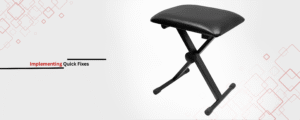benches begin to wobble due to wear and tear, loose joints, uneven legs, etc. This guide explains the most useful and gentle approaches to fix wobbly piano bench without having to involve a professional with the help of DIY bench repair.
To know more, read: Piano Bench with Storage: A Space-Saving Solution for Musicians
Finding the source of unsteadiness
Inspect Screws and Bolts:
Hardware comes first since screws, bolts or other fasteners tend to come loose with regular use. All visible joints should be checked and tightened, and a Phillips-head screwdriver or wrench should do the job. Loosening in the future can be avoided by using thread-locking adhesive.
Adjusting Legs:
Legs that are not parallel to each other move up and down and are very common. A wedge can be placed on the level of each leg, which will enable you to tell if the surface is horizontal or inclined. If legs are indeed unbalanced, the addition of felt pads or sandpaper can balance things out.
Inspect the Joins and Frame:
If time goes on, wooden joints or metal welds will almost certainly degrade, which causes instability. It is crucial to find so-called stress fractures or rust along parts of the bench as damage, flaking, or disintegrating paint fills surfaces.
Implementing Quick Fixes
Tightening and Reinforcing Connections:
Turning screws and bolts should be done gradually and will often require a firm touch but not overtightening or over-torquing. Jigsaw puzzles fitted within a wooden bench can benefit from applying wood glue on the joints that have cracks before putting them back together. Weld repair kits or epoxy putties can be advantageous for little fractures on metal frames.
Adjusting Leg Lengths:
Step legs that are uneven could either have stick-on furniture pads on the shorter legs or have the longer legs sanded down using rough-grade sandpaper. Uploaded self-leveling adjustable feet can also be added to further adjust and help balance the levels with precision.
Adding Stabilizing Accessories:
Weighted bases or rubberized anti-slip mats can be put at the bottom of the benches to limit their movement. Adding L-brackets or cross braces may also help to reinforce the structural integrity of the frame.
When Replacement Becomes Necessary
Evaluating Irreparable Damage:
Highly corroded metal, or cracked frames, or even wood that has warped too much may be too much to deal with when it comes to repairing and rebuilding a bench. In replacing parts or investing in a new bench would save you the trouble of thinking of ways to maintain safety.
Upgrading for Enhanced Features:
For longer, makeshift, adjustable benches, ergonomic structural designs and reinforced materials, lest the bench be damaged permanently, would be a more favorable choice. Further comfort and durability can be achieved with memory foam padding and even height-adjusted hydraulics.
Cost-Benefit Analysis:
Restoring sentimental pieces may make a professional restoration service a suitable option. The cost of repair tools and parts also has to be considered in comparison with buying a new replacement.
Need this in bulk? You can get this from wholesale – piano bench
If you need this at the best prices, you might check out this new platform – piano bench
What Techniques Can Be Used to Stabilize a Wobbly Piano Bench?
For moderate cases, the fixation of screws on tetrapod joints is solved with a hex key or a screwdriver to stabilize keyboard bench. Wooden benches are more complex, requiring glue or epoxy on damaged wooden dowels or tenons. Legs that don’t come into contact with the ground can be adjusted by either sanding the longer leg or mounting sandpaper to the shorter leg. Loose rubber caps that cling to the rim of the vertical supports or individually adjustable support screws increase stability on leveled surfaces. In cases where flexing does not stop, cross-bracing hardware or a stronger seat plate should be used to shift the focus of movement.
Conclusion
A simple tweak will fix a wobbly piano bench whose problem is with the alignment, but if the problem persists, perhaps getting a new one is the better option. It is well known that casual and professional pianists use benches from brands like Roland, 5 Core, and Donner owing to the ergonomic design and high durability of their products. Current solutions for piano benches offer ease of access and enhanced stability, but there is no clear answer to what the future holds for piano bench design. Perhaps new materials would change how maintenance is done, or smart technology could bring about other possibilities. The advancement of the world poses a mystery for the time being, but one thing is for sure: we need a solid basis for free expression through art, which in this case is music.




